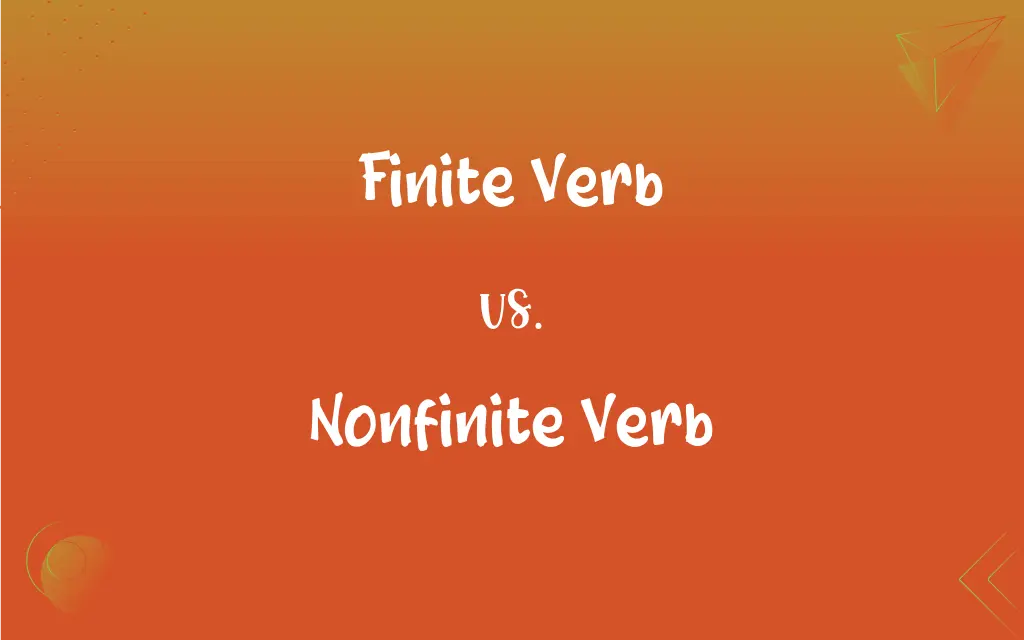Finite Verb vs. Nonfinite Verb: What's the Difference?
Edited by Aimie Carlson || By Harlon Moss || Updated on October 24, 2023
Finite verbs change form based on subject and tense, whereas nonfinite verbs don't exhibit such changes.

Key Differences
Finite verbs are verbs that have a specific tense, number, and person. They can act as the main verb in a sentence and change forms according to the subject's number and person. For instance, in the sentence "She sings," "sings" is a finite verb agreeing with its third-person singular subject. In contrast, nonfinite verbs do not change form based on tense, number, or person. They can't stand alone as the main verb without an auxiliary.
Nonfinite verbs come in three primary forms: infinitives, gerunds, and participles. For example, in "To read is fun," "to read" is an infinitive and a nonfinite verb. The characteristic that sets nonfinite verbs apart is their inability to dictate the number or person of the subject. On the other hand, finite verbs will always indicate a specific time, whether it's past, present, or future, by their form.
In many sentences, finite verbs and nonfinite verbs can appear together. Consider "She wants to dance." Here, "wants" is a finite verb because it changes based on the subject and tense, while "to dance" is a nonfinite verb in the infinitive form. The finite verb provides the primary action or state of the subject, while the nonfinite verb often provides additional information or context.
Understanding the difference between finite verbs and nonfinite verbs is crucial for mastering English grammar. Recognizing a finite verb helps in determining the sentence's tense and agreement, while nonfinite verbs are essential for constructing various verb forms and adding depth or detail to sentences.
Comparison Chart
Agreement
Changes based on subject/tense
Doesn't change
ADVERTISEMENT
Types
Main verbs in sentences
Infinitives, gerunds, participles
Tense Indication
Indicates specific tense
Doesn't indicate tense
Standalone Capability
Can stand alone as main verb
Requires auxiliary verb
Example
"She reads."
"Reading is fun."
Finite Verb and Nonfinite Verb Definitions
Finite Verb
The finite verb agrees in number and person with its subject.
He writes a letter.
ADVERTISEMENT
Nonfinite Verb
Nonfinite verbs don't provide tense information on their own.
I am excited to travel.
Finite Verb
A sentence's primary verb, showing action or state, is typically finite.
The cat sleeps on the couch.
Nonfinite Verb
Nonfinite verbs don't change form for tense, number, or person.
To walk is enjoyable.
Finite Verb
A finite verb changes form based on its subject and tense.
She runs every morning.
Nonfinite Verb
Nonfinite verbs include infinitives, gerunds, and participles.
Written words last forever.
Finite Verb
Finite verbs provide specific tense information in sentences.
They played soccer.
Nonfinite Verb
These verbs can't serve as the main verb without an auxiliary.
She likes to read novels.
Finite Verb
Finite verbs can stand alone as the main action in a sentence.
Birds sing.
Nonfinite Verb
They often function as nouns, adjectives, or adverbs in sentences.
Running is her hobby.
FAQs
Can a finite verb stand alone?
Yes, a finite verb can stand alone as the main verb of a sentence.
What is a finite verb?
A finite verb is a verb that has a specific tense, person, and number, and can function as the main verb in a clause.
Do finite verbs change forms?
Yes, they change according to tense, person, and number.
What is the difference between "to" + verb and an infinitive?
The combination of "to" + verb is called the full infinitive, and it is a type of nonfinite verb.
Can a sentence have more than one finite verb?
Yes, in compound tenses or compound sentences. E.g., "He reads the book and writes an essay."
Can infinitives be finite verbs?
No, infinitives are nonfinite verb forms.
What’s the difference between a verb and a finite verb?
All finite verbs are verbs, but not all verbs are finite. Finite verbs show tense, person, and number.
What is a nonfinite verb?
A nonfinite verb is a verb form that does not show tense, person, or number. Common nonfinite forms include infinitives, gerunds, and participles.
Can a nonfinite verb act as the main verb of a sentence?
No, it typically cannot stand alone as the primary verb in a main clause.
Is "having" in "having eaten" a nonfinite verb?
Yes, "having" is part of the perfect participle "having eaten."
How can I identify a finite verb in a sentence?
Look for a verb that changes form based on the subject and shows tense, such as "she sings" vs. "she sang."
What are examples of nonfinite verbs?
"To run" (infinitive), "running" (gerund), and "run" (past participle) in "run."
How are nonfinite verbs used in sentences?
They can function as nouns, adjectives, or adverbs, such as "Running is fun" (gerund as noun) or "The running water" (participle as adjective).
Can nonfinite verbs have a subject?
Not directly, but they can have implied subjects, as in "him seeing her" where "him" is the implied subject of "seeing."
Can nonfinite verbs take objects?
Yes, for instance, "to read a book" where "a book" is the object of the infinitive "to read."
Are auxiliary verbs considered finite?
They can be if they indicate tense, person, or number. For instance, "is" in "She is singing."
Do other languages have nonfinite verbs?
Yes, many languages have verb forms that do not indicate tense, person, or number, functioning similarly to nonfinite verbs in English.
Is "were" in "If I were you" a finite verb?
Yes, it's a finite verb in the subjunctive mood.
Do other languages have finite verbs?
Yes, many languages have verb forms that change based on tense, person, and number.
Do nonfinite verbs change forms?
Generally, no. They don’t change with the subject or tense.
About Author
Written by
Harlon MossHarlon is a seasoned quality moderator and accomplished content writer for Difference Wiki. An alumnus of the prestigious University of California, he earned his degree in Computer Science. Leveraging his academic background, Harlon brings a meticulous and informed perspective to his work, ensuring content accuracy and excellence.
Edited by
Aimie CarlsonAimie Carlson, holding a master's degree in English literature, is a fervent English language enthusiast. She lends her writing talents to Difference Wiki, a prominent website that specializes in comparisons, offering readers insightful analyses that both captivate and inform.































































